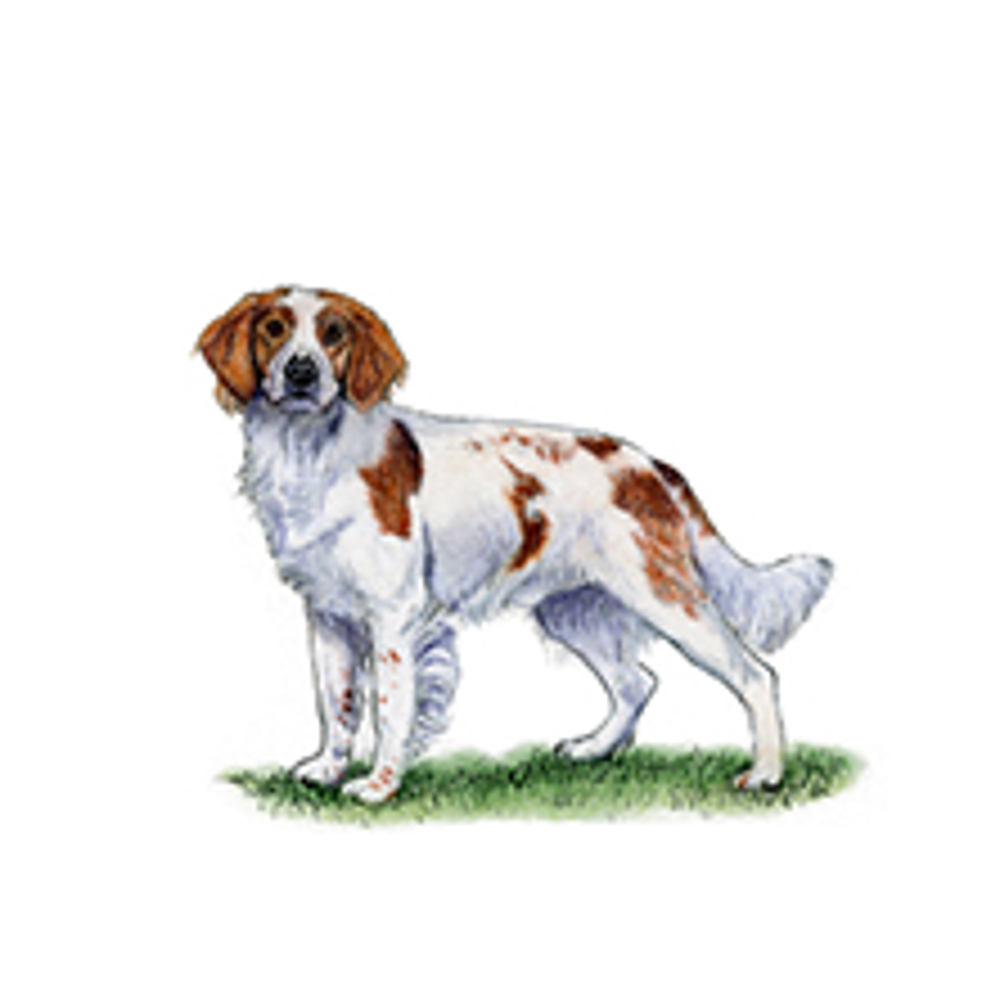
Brittany
Breed characteristics
- Size
- Medium
- Exercise
- More than 2 hours per day
- Size of home
- Small house
- Grooming
- More than once a week
- Coat length
- Medium
- Sheds
- Yes
- Lifespan
- Over 10 years
- Vulnerable native breed
- No
- Town or country
- Country
- Size of garden
- Large garden
About this breed
In France the breed carries the name Epagneul Breton – the Brittany Spaniel – and was founded on a breed of spaniel found in Northern France known locally as 'Le Fougere'. To this foundation was added some English Setter and Pointer blood to give scenting and pointing qualities and the result was the Brittany – a short backed, cobby dog capable of flushing, pointing and retrieving – a true HPR breed. For this reason the nomenclature was changed and the word 'spaniel' was dropped.
The breed is often, but not always naturally bob tailed and for this reason the first breed club in France, when founded in 1907, carried the title The Short Tailed Brittany Club.
Images for this breed
The Gundog breed group
Dogs that were originally trained to find live game and/or to retrieve game that had been shot and wounded. This group is divided into four categories - Retrievers, Spaniels, Hunt/Point/Retrieve, Pointers and Setters - although many of the breeds are capable of doing the same work as the other sub-groups. They make good companions, their temperament making them ideal all-round family dogs.
Colour Watch
Category 0: Breeds with no NBS colour registration options.
Read more about Colour Watch.
Breed Standard colours
Breed standard colour means that the colour is accepted within the breed standard and is a traditional and well-known colour in this breed.
Breed standard colours in this breed include:
- Black & White
- Black & White Roan
- Black Tricolour
- Liver & White
- Liver Tricolour
- Orange & White
- Orange & White Roan
- Tricolour
Other colour/s
'Other' means you consider your puppy to be a colour not currently known within the breed and one that does not appear on either the breed standard or non-breed standard list. In this instance you would be directed through our registrations process to contact a breed club and/or council to support you on identifying and correctly listing the new colour.
Non-breed-standard colours
Non-breed-standard colour means that the colour is not accepted within the breed standard and whilst some dogs within the breed may be this colour it is advised to only select a dog that fits within the breed standards for all points.
Colour is only one consideration when picking a breed or individual dog, health and temperament should always be a priority over colour.
Health
Whether you’re thinking of buying a puppy, or breeding from your dog, it’s essential that you know what health issues may be found in your breed. To tackle these issues we advise that breeders use DNA tests, screening schemes and inbreeding coefficient calculators to help breed the healthiest dogs possible.
More about health
Priority health schemes and tests
The Kennel Club's Assured Breeders must use the following (or equivalent) schemes, tests and advice. All other breeders are strongly advised to also use these.
Important health schemes and tests
We strongly recommend that all breeders, both assured breeders (ABs) and non ABs, use the following (or equivalent) schemes, tests and advice.
Find out about a particular dog's results
Please visit our Health Test Results Finder to discover the DNA or screening scheme test results for any dog on The Kennel Club's Breed Register.
You can also view the inbreeding coefficient calculation for a puppy's parents, or for a dog you're thinking of breeding from.
Have any questions about health in your breed?
If you have any concerns about a particular health condition in your breed then you may wish to speak to your vet or you could contact your breed health co-ordinator.
Breed health co-ordinators are individuals working on behalf of breed clubs and councils who are advocates for the health and welfare of their chosen breed. They acts as a spokesperson on matters of health and will collaborate with The Kennel Club on any health concerns the breed may have.
To contact your breed health co-ordinator please email:
Breed watch
Category 1
Currently no points of concern specific to this breed have been identified for special attention by judges, other than those covered routinely by The Kennel Club's breed standard.
Breeding restrictions
There are a number of The Kennel Club's rules and regulations that may prevent a litter from being registered, find out about our general and breed specific breeding restrictions below.
More about breeding
In October 2008, our Board agreed to record puppies that are born with naturally bobbed tails on registration certificates. The decision was made in order to help breeders identify which dogs or lines carry the tailless gene. The word bobtail is the only description of the tail which is accepted. The description of any other tail length or tails which are not naturally bobbed, such as full tail or legally docked will not be recorded. Confirmation of the tail status of puppies must be accompanied by veterinary certification (on practice headed paper) and sent with the litter registration form. As veterinary certification is required to record the status, this service is not available online.
Looking for a puppy?
Looking for a Brittany? Explore our list of puppies and rescue dogs for sale near you.
